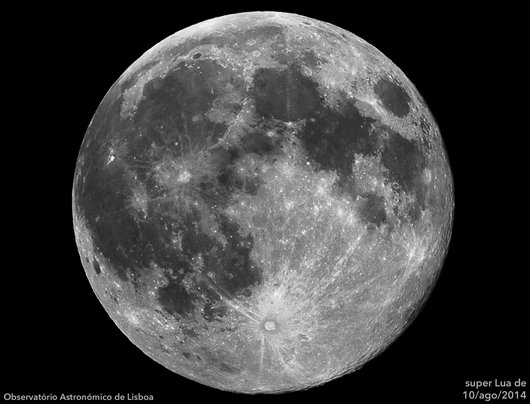 The first of the three Super Moons for this year of 2015 will occur on Saturday, August 29, when the Moon is simultaneously in the Full Moon phase and at a distance from Earth less than 110% of the perigee of its orbit. An Super Moon is a phenomenon where Earth's natural satellite appears larger than usual.
The first of the three Super Moons for this year of 2015 will occur on Saturday, August 29, when the Moon is simultaneously in the Full Moon phase and at a distance from Earth less than 110% of the perigee of its orbit. An Super Moon is a phenomenon where Earth's natural satellite appears larger than usual.
On that day, the Moon will be in the Full Moon phase at 19:35 and will reach perigee (358290 kilometers from Earth) on Sunday 30th at 16:22 (Lisbon time), with the two events only out of phase with each other by 20:45.
On the 29th, the Moon rises at 19:59 pm, shortly after the moment of Full Moon. At that point, the Moon will appear larger than usual, not only due to the occurrence of Super Moon, but also because, being close to the horizon, there is an extra magnifying effect (due to cerebral interpretation). The next day, the 30th, the moon rises at 20:40 pm and will continue to look bigger than usual.
According to Lisbon Astronomical Observatory, in this late Summer and early Autumn, all Full Moons, which will take place on August 29th, September 28th and October 27th, will be Super Moons.
The moments of Full Moon will not coincide exactly with the moments of perigee, but they will be very close.
The most favorable Super Moon to observe will be on September 28, when the perigee and full moon moments are only 66 minutes apart.
The best time to observe the Super Moon is when the moon is close to the horizon at the time of your birth, as there is an extra magnifying effect, but it is just an illusion produced for reasons not yet fully understood by astronomers and psychologists.
We speak of Super Moon whenever the Full Moon instant occurs when the Moon is less than 110% of the perigee of its orbit from Earth.
In temporal terms, this means that the difference between the times of Full Moon and perigee is less than 1 day and 8 hours.
According to this definition, it is possible to have a Super Moon in consecutive months when the difference between the anomalistic period (between two passages in perigee) and the synodic period (between two moments of full moon) is less than 1 day and 8 hours.
The number of Super Moons in a year will be greater the smaller the difference between these two periods. Thus, it is very frequent the occurrence of two Super Moons in a year (in consecutive months) and in some years it is even possible for the occurrence of three super Moons, as is the case of this year.
The set of Super Moons repeats with a frequency of 13 months and 18 days, so the two or three Super Moons of a given year occur one to two months later than they had occurred in the previous year.
In September's Super Moon, its Full Moon instant will occur on Sunday, the 28th, at 03:52 am, while the perigee will occur at 02:46 am, that is, a delay of only 66 minutes.
In 2016, it will be the 14th of November that the Full Moon will occur closer to the perigee.


















Comments